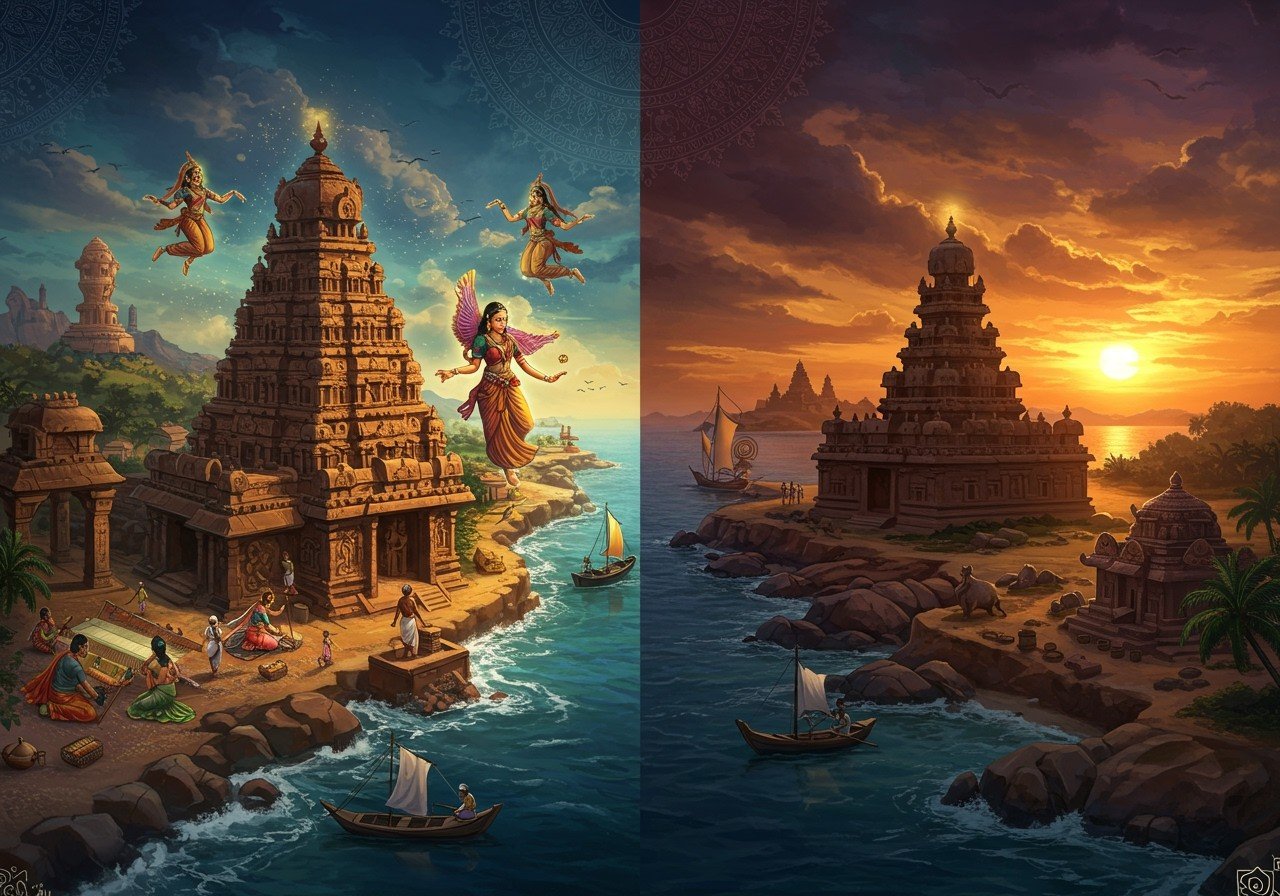
The Pallava Dynasty, a significant power in South India, reigned from the 3rd to the 9th century CE. Known for their contributions to art, architecture, and culture, the Pallavas established two prominent capitals: Kanchipuram and Mamallapuram. This blog post explores the historical significance, cultural heritage, and architectural marvels of these ancient cities, examining their roles as capitals of the Pallava Dynasty.
Historical Overview of the Pallava Dynasty
The Pallava Dynasty started as a feudatory of the Satavahanas. Their rise to prominence is linked to rulers like Simhavishnu, who expanded the kingdom’s territory, and Mahendravarman I (7th century CE), known for his administrative and military achievements. The Pallavas fostered a rich cultural environment, supporting art and literature. Over time, their power waned, eventually succumbing to the Chola Empire. However, their impact on South Indian history remains significant.
Kanchipuram: The Spiritual Capital
Kanchipuram served as the primary capital and spiritual center of the Pallava Dynasty from the 3rd century to the 9th century CE. Famous for its magnificent Hindu temples dedicated to Shiva and Vishnu, Kanchipuram became a vital hub for religion and philosophy. The city also made significant contributions to Tamil literature and education, with institutions like the Kanchi Kamakoti Peetham playing a crucial role.
Notable architectural landmarks in Kanchipuram include:
- Kailasanathar Temple: This temple is celebrated for its intricate carvings, showcasing the architectural prowess of the Pallavas. It is one of the oldest structural temples in South India, dedicated to Lord Shiva.
- Ekambareswarar Temple: One of the largest temples in India, the Ekambareswarar Temple is dedicated to Lord Shiva and boasts a towering gopuram (gateway tower). It is a testament to the Pallava Dynasty’s architectural ambition and religious devotion.
Mamallapuram: The Architectural Marvel
Mamallapuram, also known as Mahabalipuram, rose to prominence as a secondary capital under Narasimhavarman I in the 7th century CE. Its strategic coastal location facilitated maritime trade and cultural exchange. Today, Mamallapuram’s monuments are recognized as UNESCO World Heritage sites.
Key attractions in Mamallapuram include:
- Shore Temple: This iconic temple, perched on the shoreline, is a symbol of Mamallapuram’s architectural heritage. Its unique location and intricate carvings make it a must-visit.
- Pancha Rathas: These five monolithic rock-cut temples, each dedicated to a different deity, showcase the Pallavas’ mastery of rock-cut architecture. They represent a remarkable blend of architectural and sculptural artistry.
The Pallavas excelled in rock-cut architecture and sculpture, evident in masterpieces like Arjuna’s Penance and the Varaha Cave Temple.
Cultural Contributions and Legacy
The Pallava Dynasty significantly impacted South Indian culture, advancing art, music, and dance. Scholars and poets like Bharavi and Dandin thrived under their patronage, enriching Tamil and Sanskrit literature. Their architectural innovations, particularly in Dravidian styles, influenced later dynasties like the Cholas and the Vijayanagar Empire.
Connecting with Pallava Heritage through Poojn.in
Poojn.in, India’s leading online store for cultural and religious goods, offers a unique opportunity to connect with the rich heritage of the Pallava Dynasty. Whether you’re planning a visit to Kanchipuram or Mamallapuram, or simply wish to honor the traditions of this era, Poojn.in provides a wide selection of authentic puja items, including:
- Traditional brass lamps and diyas: Illuminate your home with the same style of lamps used in ancient Pallava temples. Browse our collection.
- Incense sticks and dhoop: Create a sacred atmosphere with fragrances traditionally used in South Indian temples. Explore our range of incense.
- Statues and idols of deities: Bring the divine presence of Shiva and Vishnu into your home with beautifully crafted statues. Find your perfect deity.
- Pooja accessories: Enhance your puja rituals with traditional items like bells, plates and other puja essentials. Discover our puja accessories.
Visit poojn.in today to discover a wide array of products that can help you connect with the spiritual and cultural legacy of the Pallava Dynasty.
FAQs
What was the significance of Kanchipuram and Mamallapuram during the Pallava Dynasty? Kanchipuram served as the spiritual and administrative center, while Mamallapuram flourished as a port city and a center for artistic expression.
What are some must-see Pallava sites in these cities? In Kanchipuram, the Kailasanathar and Ekambareswarar Temples are essential visits. In Mamallapuram, the Shore Temple, Pancha Rathas, and Arjuna’s Penance are highlights.
How did the Pallavas influence later South Indian dynasties? The Pallavas’ architectural style, particularly their rock-cut temples, and their contributions to art and literature significantly influenced the Cholas and Vijayanagar empires.
Conclusion
The Pallava Dynasty’s legacy, preserved in the historical cities of Kanchipuram and Mamallapuram, continues to captivate and inspire. These cities stand as testaments to a glorious era marked by artistic innovation, architectural brilliance, and spiritual devotion. Exploring these sites offers a profound connection to South India’s rich cultural heritage.


